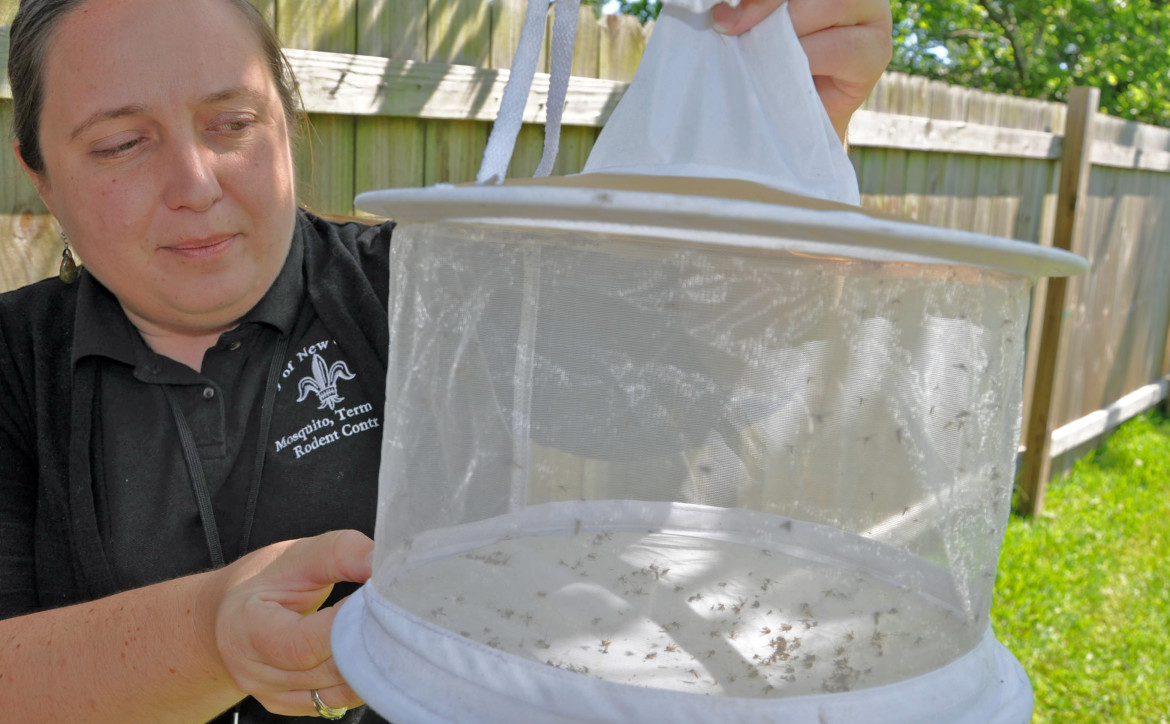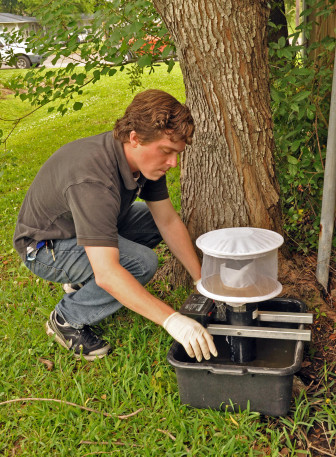
Entomologist Sarah Michaels peered carefully into the mesh collection sack from the city mosquito trap off Press Street. Several hundred were inside, but none looked like the one she was most interested in: Aedes aegypti, the species that can transmit Zika virus.
That was certainly good news — but not of the blind luck kind, either.
Turns out local experts in mosquito control aren’t as worried about Zika as other mosquito-friendly spots in the United States because New Orleans has been controlling mosquitos for more than 50 years.
This year alone, it has 30 employees and a budget of $2 million to get the job done. They trap mosquitoes year-round and test them for pathogens, search out and eradicate breeding habitat and, when concentrations become large enough, spray for the insects with trucks and airplanes.
“Part of that program is to look and see what’s on the horizon,” said Michaels’ boss, Claudia Riegel, director of the New Orleans Mosquito, Termite and Rodent Control Board. “And as soon as we saw Zika cases in Brazil we began focusing on that.”
Since first identified in 1947 in the Zika Forest of Uganda, the virus gained little notoriety because it has almost no symptoms except sometimes fever, rash, joint pain and red eye. The Centers for Disease Control says most victims “won’t even know they have the disease.”
But alarms bells went off when an outbreak of microcephaly — abnormal brain growth — in the fetuses of pregnant Brazilians was linked to the mosquito-borne virus.
That’s because mosquitos are nature’s version of dirty needles. Once they suck virus-infected blood from one human, they can inject the disease into the next person they bite.
And infected humans are among the most feared vectors of communicable disease because they can travel great distances in short periods of time, often to as-yet-unaffected areas with high populations.
As of last week, only four cases of Zika had been reported in Louisiana, one of which was in New Orleans. Michaels said each of those was an instance of people who were infected while traveling in Zika hotspots. She said all had recovered and no cases have been found of victims being infected locally.
Michaels said once the local case was reported, mosquito-control staffers immediately spread out across the victim’s neighborhood collecting mosquitoes and running lab checks for Zika. They were negative.
“We coordinate with the city and state health departments,” Michaels said. “This might be new to other cities, but it’s pretty standard procedure here.”
That’s because New Orleans has a long history with the Aedes aegypti. This is the same insect that transmits yellow fever, the disease that killed 41,000 New Orleanians between 1817 and 1905. It only began to loosen its grip on the city when researchers proved it was spread primarily by this one mosquito species.
As soon as the city began a rigorous campaign to control breeding sites, infections dropped dramatically. Later invention of a vaccine eventually made yellow fever almost unheard of nationwide.
Unfortunately, Louisiana is home to about 60 different mosquito species, many of which thrive in the local sub-tropical habitat. Species that occur here have been shown to be carriers of a number of debilitating viruses, including West Nile, chikungunya, degue fever, malaria and now Zika.

Even when they aren’t spreading disease, they are causing plenty of unhappiness. In fact, it was residents’ frustration with two invasions of the stinging salt marsh mosquitos in 1954 that led to the development of the modern Mosquito Control Board.
The arrival of Zika has once again transformed the city’s nonstop battle from a matter of mere comfort to one of serious health concerns, resulting in the New Orleans city government to issuing a 50-page Zika control plan. It closely follows practices the control board has been following for more than five decades: reduce breeding sites for the Aedes species, report high concentrations, and spray from trucks or planes when populations become a problem. Michaels said the most commonly used insecticide is the EPA-approved malathion.
However she said the best prevention is removing the very specific habitat the Aedes species prefer and that rainy, crowded New Orleans has in abundance: small containers filled with water.
“By small containers we’re talking about pet food bowls, cans and glasses, the lids on ice chests and even the cup holders on the top of ice chests. Things of that size,” Michaels said.
She said property owners should follow the same routine the city workers use when making regular neighborhood inspections:
- Remove any trash and clutter from the yard that can collect water, including old tires, tarps, toys, ice chests, trash can covers and the like.
- Containers that must remain open, such as pet dishes and birdbaths, should be emptied often and refilled.
- Although it takes about a week for eggs to hatch, eggs can remain viable even when dry for months at a time. So wiping the containers with a rag to remove any eggs is recommended.
- Manage lawns so they don’t hold standing water for days.
- Use insect repellent if you’re going to be outdoors when mosquitoes are most active – around sunrise and sunset.
- Cover any structures used to store stormwater, such as rain barrels or cisterns, and make sure rain gardens drain properly.
Riegel said the projects in the city’s new effort to reduce flooding by storing stormwater on landscape features must pass muster with her agency. The same holds for property developers who fall under the new Comprehensive Zoning Ordinance requiring stormwater management.
“We’re consulted to make sure none of the projects will be holding water long enough to allow breeding, which is typically about a week,” she said.
Although peak mosquito season are the hot-weather months just beginning, the Aedes species can be found whenever the temperature is warm enough.
“Never stop checking for those small containers,” Michaels said. “When you see them, empty them.”


